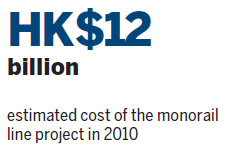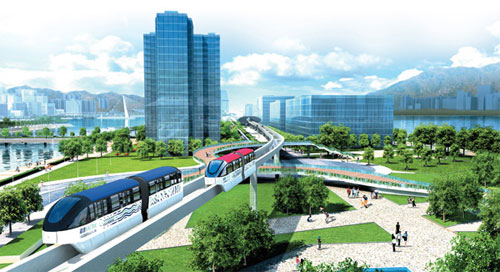Monorail plan remains daunting challenge
Updated: 2015-09-23 09:14
By Timothy Chui in Hong Kong(HK Edition)
|
|||||||||
By Similar ventures in Seattle and Sydney have failed to live up to expectations
The government's efforts to remake East Kowloon into a model smart city have begun to make progress - but the biggest challenge remains an ambitious plan to build the city's first ever monorail line.
The bold idea to redevelop 320 hectares of land in Kwun Tong and Kowloon Bay into a fully wired, big-data-managed model for efficient city planning and living is now underway.
Some small-scale initiatives have already begun such as zebra crossing improvements, better pedestrian connectivity, new parks, concrete-wall greening and rejuvenating alleyways.
A new waterfront boulevard which opened in May is expected to be popular during the Mid-Autumn Festival, according to deputy head of Energizing Kowloon East Office Winnie Ho Wing-yin.
The private sector has also responded to the new vision for an area which was once dominated by factories. Some 16 environmentally friendly building designs have been produced since the government imposed new conditions on land sales. These require developers to minimize the environmental impact of projects. Plans are also underway to make the entire district a Wi-Fi hotspot.
Essential to these mini projects and a proposed second central business district is a plan to link the high density model smart city with the rest of Hong Kong. This will be done via a monorail running through the old Kai Tak airport, Kwun Tong, Kowloon Bay and Kowloon City.
Legislative Council Panel on Transport Chairman Michael Tien Puk-sun said that originally the project was estimated to cost HK$12 billion in 2010, and start operating by 2023. But it is now likely to cost at least 50 percent more. The potential benefits cannot really be quantified. This is because the monorail's success would lead to an upgrading of the city's existing light rail network. This carries half a million passengers daily - far exceeding its original design parameters.
"A new system to supersede the light rail has to be an elevated system. Hong Kong's roads are only going to get more congested with pedestrians and cars and if the East Kowloon monorail system works, it'll be a preview to upgrading the entire light rail system in the Northwest New Territories," Tien said.
Hong Kong Polytechnic University Department of Civil and Structural Engineering Associate Professor Hung Wing-tat said a proposed alternative from Hong Kong Tramways would cost roughly a quarter of the monorail. This had been quietly dropped from public consultations in 2013. But he said it was a better solution. This was because land resumption for a monorail in Ngau Tau Kok and Kwun Tong would be difficult as it would require large, overhanging structures to be built.
"Trams are more suitable and offer less visual intrusion. Being closer to the ground, people can walk at grade and it would be much cheaper and easier to deliver within the proposed schedule," Hung said.

The tram proposal also fits in with pedestrian-friendly goals for the district. Letting the district's 640,000 residents decide whether they wanted a monorail or a tram would reinforce a pledge to involve the community at every level of planning.
As well as rising costs and delays over the Express Rail Link and the Hong Kong-Zhuhai-Macao Bridge, the costs of capital works projects within East Kowloon are also worrying government officials. The Kai Tak Development Plan's southern development has already breached the HK$5.7 billion level for only 2 km of road works. This includes new roads, elevated decks, noise barriers and other preparatory works.
Monorails have been successfully implemented elsewhere - such as the Chongqing Rail Transit, which has the record as the world's largest and busiest.
However, other ventures overseas have failed to live up to expectations, such as the Sydney Monorail. This closed down after a 25-year run marred by criticism of lackluster patronage and an incident where stranded passengers had to wait hours to be rescued via cherry pickers.
A failed attempt in Seattle, Washington from 1997 to 2005 resulted in $124.7 million in taxpayer money being spent without any construction work taking place.
tim@chinadailyhk.com
|
The proposed Environmentally Friendly Linkage System (EFLS) is an elegant elevated 9-kilometer, 12-station monorail. It will run on parallel tracks from the MTR Kowloon Bay Station through the Kai Tak Development and across a new Kwun Tong Transportation Link above the entrance of the Kwun Tong Typhoon Shelter to the MTR Kwun Tong Station. Photo provided to China Daily |
(HK Edition 09/23/2015 page7)
